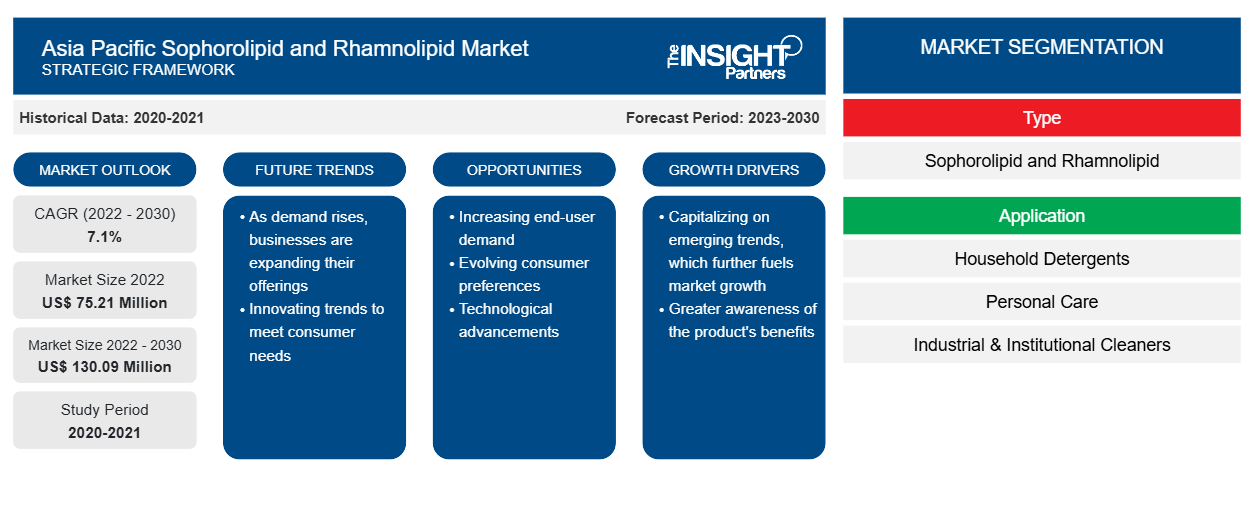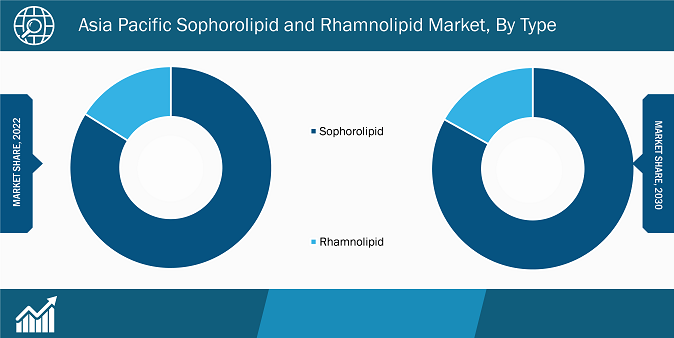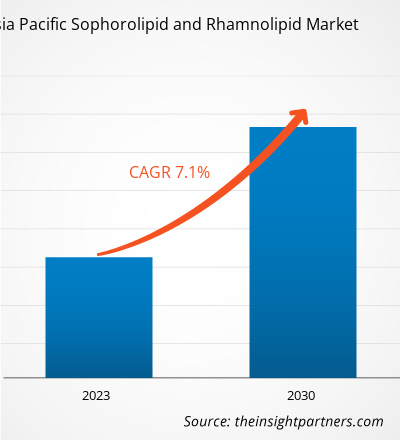The Asia Pacific sophorolipid and rhamnolipid market accounted for US$ 75.21 million in 2022 and is expected to reach US$ 130.09 million by 2030; the market is estimated to record a CAGR of 7.1% from 2022 to 2030.
Market Insights and Analyst View:
Sophorolipids and rhamnolipids are known as surface-active glycolipid compounds that can be synthesized by a selected number of nonpathogenic yeast species. They are potential bio-surfactants owing to their biodegradability and low eco-toxicity. Besides biodegradability, low toxicity, and high production potential, sophorolipids have a high surface and interfacial activity. Sophorolipids are commercially produced from vegetable oil and glucose by adding nonpathogenic yeast. Rhamnolipid is commercially produced from glycerol by adding nonpathogenic yeast called Pseudomonas aeruginosa. Sophorolipids and rhamnolipids are widely used in agriculture products such as pesticides and other chemicals; detergents for residential, medical, and healthcare usage; and personal care and cosmetic products such as shampoo, hand wash liquid, and soap.
Customize This Report To Suit Your Requirement
You will get customization on any report - free of charge - including parts of this report, or country-level analysis, Excel Data pack, as well as avail great offers and discounts for start-ups & universities
Asia Pacific Sophorolipid and Rhamnolipid Market: Strategic Insights

- Get Top Key Market Trends of this report.This FREE sample will include data analysis, ranging from market trends to estimates and forecasts.
You will get customization on any report - free of charge - including parts of this report, or country-level analysis, Excel Data pack, as well as avail great offers and discounts for start-ups & universities
Asia Pacific Sophorolipid and Rhamnolipid Market: Strategic Insights

- Get Top Key Market Trends of this report.This FREE sample will include data analysis, ranging from market trends to estimates and forecasts.
Growth Drivers and Challenges:
Sophorolipids offer several advantages over chemical surfactants, such as high biodegradability, diversity of biological properties, and renewable characteristics being synthesized as a mixture of different molecules. Sophorolipids have various properties, including antimicrobial and antioxidant activity, that allow their application in different industries such as detergents and personal care. Further, rhamnolipids are highly used in applications across many industries, such as bioremediation, cosmetics, agriculture, food processing, and pharmaceuticals owing to their efficient surface and biological capabilities. Rhamnolipids effectively lower surface tension, exhibit low toxicity, have a strong wetting ability, and promote the biodegradation of poorly soluble substrates. Therefore, rising awareness regarding the advantages associated with the usage of sophorolipids and rhamnolipids is propelling their use in different application sectors such as personal care & cosmetics, household detergent, industrial cleaners, agriculture, food processing, and leather processing, thereby driving the Asia Pacific sophorolipid and rhamnolipid market growth. However, the high cost of rhamnolipids and sophorolipids limits their use in different application sectors, restraining the Asia Pacific sophorolipid and rhamnolipid market growth. The cost of producing rhamnolipids is high due to the poorer yields than commercial synthetic surfactants.
Report Segmentation and Scope:
The "Asia Pacific Sophorolipid and Rhamnolipid Market" is segmented on the basis of type, application, and country. Based on type, the Asia Pacific sophorolipid and rhamnolipid market is bifurcated into sophorolipid and rhamnolipid. By application, the Asia Pacific sophorolipid and rhamnolipid market is segmented into household detergents, personal care, industrial and institutional cleaners, food processing, oilfield chemicals, leather processing, agriculture, pharmaceuticals, and others. Based on country, the Asia Pacific sophorolipid and rhamnolipid market is segmented into Australia, China, Japan, India, South Korea, and the Rest of Asia Pacific.
- This FREE sample will include data analysis, ranging from market trends to estimates and forecasts.
Segmental Analysis:
Based on type, the Asia Pacific sophorolipid and rhamnolipid market is segmented into sophorolipid and rhamnolipid. The sophorolipid segment held a larger share in the Asia Pacific sophorolipid and rhamnolipid market. Also, the market for the sophorolipid segment is expected to register considerable growth during 2022–2030. Sophorolipid molecules possess excellent surface-active properties, making them valuable in various applications such as personal care products, detergents, food additives, pharmaceuticals, and environmental remediation. In cosmetics, sophorolipids have gained traction as natural and biodegradable emulsifiers and foaming agents.


- This FREE sample will include data analysis, ranging from market trends to estimates and forecasts.
Regional Analysis:
Based on country, the Asia Pacific sophorolipid and rhamnolipid market is segmented into Australia, China, India, Japan, South Korea, and the Rest of Asia Pacific. The Asia Pacific sophorolipid and rhamnolipid market was dominated by China, which accounted for ~US$ 31 million in 2022. Japan is a second major contributor holding more than 15% Asia Pacific sophorolipid and rhamnolipid market share. The market in South Korea is expected to register a CAGR of 9% from 2022 to 2030. The sophorolipid and rhamnolipid market in South Korea is witnessing significant growth due to the increasing demand for sustainable and eco-friendly products in various industries. The country has emerged as a key player in the production of sophorolipids and rhamnolipids due to its growing focus on sustainable technologies and innovative research.
Industry Developments and Future Opportunities:
Various initiatives taken by the key players operating in the Asia Pacific sophorolipid and rhamnolipid market are listed below:
- In 2021, BASF SE established a strategic alliance with Allied Carbon Solutions Co Ltd (ACS) Japan, a commercial biomass surfactants provider, including an equity stake.
- In 2023, Holiferm Ltd and Sasol Chemicals, a business unit of Sasol Ltd., announced a collaboration to produce and market rhamnolipids and mannosyl erythritol lipids (MELs). This collaboration expands the partnership announced in March 2022 between the two companies to develop and commercialize another biosurfactant product, sophorolipids.
- In 2022, Evonik announced an investment in the construction of a new production plant for bio-based and fully biodegradable rhamnolipids. The investment in the Slovenská Ľupča site in Slovakia strengthens Evonik's partnership with the consumer goods group Unilever, which began in 2019. At the same time, the investment allows Evonik to further expand its biosurfactant business. The new plant is scheduled to come on stream in two years.
- In 2022, Evonik launched a rhamnolipid, Rewoferm RL 100. This biosurfactant meets demands for low-emission, low-impact cleaning products that enable a circular economy. Rewoferm RL 100 is produced from renewable feedstocks sourced in Slovakia, where its new biosurfactant plant is based and is fully biodegradable while providing excellent cleaning performance.
COVID-19 Pandemic Impact:
During the COVID-19 pandemic, lockdowns, travel restrictions, and business shutdowns in Asia Pacific hampered the growth of several industries, including the chemicals & materials industry. The shutdown of manufacturing units of sophorolipid and rhamnolipid companies disturbed supply chains, manufacturing activities, and delivery schedules, negatively impacting the Asia Pacific sophorolipid and rhamnolipid market growth. Various companies reported delays in product deliveries and a slump in product sales in 2020. The negative impact of the pandemic on food, personal care, and many other industries has reduced the demand for sophorolipids and rhamnolipids.
The COVID-19 pandemic made people increasingly aware of cleanliness to stay healthy. Disinfection practices became highly important to reduce the potential for novel coronavirus contamination in healthcare settings, homes, and other places. The increased attention to hygiene and wellness during the pandemic propelled the demand for disinfecting and cleaning products, thereby driving the Asia Pacific sophorolipid and rhamnolipid market growth.
The Asia Pacific sophorolipid and rhamnolipid market began to revive in 2021 as governments of various countries took significant measures, such as well-coordinated vaccination drives. The resumption of business activities in personal care, food processing, oilfield chemicals, pharmaceuticals, and other industries gradually boosted the Asia Pacific sophorolipid and rhamnolipid market growth in 2021.
Competitive Landscape and Key Companies:
Dow Inc, Allied Carbon Solutions Co Ltd, Saraya Co Ltd, Evonik Industries AG, Givaudan SA, Godrej Industries Ltd, Holiferm Ltd, Stepan Co, Deguan Biosurfactant Supplier, and Jeneil Bioproducts GmbH are among the players operating in the Asia Pacific sophorolipid and rhamnolipid market. Players operating in the Asia Pacific sophorolipid and rhamnolipid market focus on providing high-quality products to fulfil customer demand. Also, they focus on adopting various strategies such as new product launches, capacity expansion, partnerships, and collaborations to stay competitive in the market.
Asia Pacific Sophorolipid and Rhamnolipid Report Scope
| Report Attribute | Details |
|---|---|
| Market size in 2022 | US$ 75.21 Million |
| Market Size by 2030 | US$ 130.09 Million |
| Global CAGR (2022 - 2030) | 7.1% |
| Historical Data | 2020-2021 |
| Forecast period | 2023-2030 |
| Segments Covered |
By Type
|
| Regions and Countries Covered | Asia-Pacific
|
| Market leaders and key company profiles |
- Historical Analysis (2 Years), Base Year, Forecast (7 Years) with CAGR
- PEST and SWOT Analysis
- Market Size Value / Volume - Global, Regional, Country
- Industry and Competitive Landscape
- Excel Dataset



Report Coverage
Revenue forecast, Company Analysis, Industry landscape, Growth factors, and Trends

Segment Covered
Type, Application, and Country

Regional Scope
North America, Europe, Asia Pacific, Middle East & Africa, South & Central America

Country Scope
This text is related
to country scope.
Trends and growth analysis reports related to Chemicals and Materials : READ MORE..
The List of Companies - Asia Pacific Sophorolipid and Rhamnolipid Market
- Dow Inc
- Allied Carbon Solutions Co Ltd
- Saraya Co Ltd
- Evonik Industries AG
- Givaudan SA
- Godrej Industries Ltd
- Holiferm Ltd
- Stepan Co
- Deguan Biosurfactant Supplier
- Jeneil Bioproducts GmbH

 Get Free Sample For
Get Free Sample For